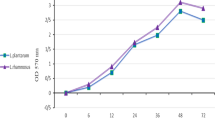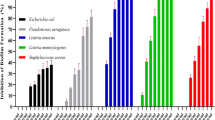Abstract
Biofilm-associated bacterial infections represent one of the major threats to modern medical treatments. Bacteria encased in biofilm matrix are more resistant towards antimicrobials and thus the capability of microbes to persist and nurture in a biofilm seems to be the foremost aspect of pathogenesis and therapeutic failure. Therefore, there is a pressing demand for new drugs active against microbial biofilms. In the current study, anti-biofilm potential of Lactobacillus spp. cell-free supernatants (CFSs) against Cronobacter sakazakii and Listeria monocytogenes was characterized using crystal violet staining and MTT assay. CFSs of goat milk origin lactobacilli not only prevented biofilm formation but also disrupted preformed biofilms. Neutralized and heat-treated preparations of Lactobacillus CFSs also inhibited biofilm formation by test pathogens. The results were quantitatively confirmed by light and fluorescent microscopy observations. Biofilms developed under static conditions displayed typical compact microcolonies with uniform distribution over the surface, while upon CFS challenge, biofilms were disrupted with presence of dead cells. These findings highlight the anti-biofilm potency of Lactobacillus spp. strains of goat milk origin and their potential application in food industries.





Similar content being viewed by others
References
Aarnisalo K, Lunden J, Korkeala H, Wirtanen G (2007) Susceptibility of Listeria monocytogenes strains to disinfectants and chlorinated alkaline cleaners at cold temperatures. Lebenson Wiss Technol 40:1041–1048
Aguilar C, Vanegas C, Klotz B (2011) Antagonistic effect of Lactobacillus strains against Escherichia coli and Listeria monocytogenes in milk. J Dairy Res 78:136–143
Allen KJ, Wałecka-Zacharska E, Chen JC, Katarzyna KP, Devlieghere F, Van Meervenne E, Osek J, Wieczorek K, Bania J (2016) Listeria monocytogenes–an examination of food chain factors potentially contributing to antimicrobial resistance. Food Microbiol 54:78–189
Awaisheh SS, Al-Nabulsi AA, Osaili TM, Ibrahim S, Holley R (2013) Inhibition of Cronobacter sakazakii by heat labile bacteriocins produced by probiotic LAB isolated from healthy infants. J Food Sci 78:M1416–M1420
Ben Slama R, Kouidhi B, Zmantar T, Chaieb K, Bakhrouf A (2013) Anti-listerial and anti-biofilm activities of potential probiotic Lactobacillus strains isolated from Tunisian traditional fermented food. J Food Saf 33:8–16
Brandão MLL, Umeda NS, Jackson E, Forsythe SJ, de Filippis I (2017) Isolation, molecular and phenotypic characterization, and antibiotic susceptibility of Cronobacter spp. from Brazilian retail foods. Food Microbiol 63:129–138
Bridier A, Sanchez-Vizuete P, Guilbaud M, Piard JC, Naitali M, Briandet R (2015) Biofilm-associated persistence of food-borne pathogens. Food Microbiol 45:167–178
Costerton JW, Stewart PS, Greenberg EP (1999) Bacterial biofilms: a common cause of persistent infections. Science 284:1318–1322
Charchoghlyan H, Kwon H, Hwang DJ, Lee JS, Lee J, Kim M (2016) Inhibition of Cronobacter sakazakii by Lactobacillus acidophilus nv Er2 317/402. Korean J Food Sci Anim Resour 36(5):635–640
Dasari S, Shouri RND, Wudayagiri R, Valluru L (2014) Antimicrobial activity of Lactobacillus against microbial flora of cervicovaginal infections. Asian Pac J Trop Dis 4:18–24
de Jesus Pimentel-Filho N, de Freitas Martins MC, Nogueira GB, Mantovani HC, Vanetti MCD (2014) Bovicin HC5 and nisin reduce Staphylococcus aureus adhesion to polystyrene and change the hydrophobicity profile and Gibbs free energy of adhesion. Int J Food Microbiol 190:1–8
de la Fuente-Nunez C, Reffuveille F, Fernandez L, Hancock RE (2013) Bacterial biofilm development as a multicellular adaptation: antibiotic resistance and new therapeutic strategies. Curr Opin Microbiol 16:580–589
de la Fuente-Nunez C, Reffuveille F, Haney EF, Straus SK, Hancock RE (2014) Broad-spectrum anti-biofilm peptide that targets a cellular stress response. PLoS Pathog 10:e1004152
de Martinis EC, Publio MR, Santarosa PR, Freitas FZ (2001) Antilisterial activity of lactic acid bacteria isolated from vacuum-packaged Brazilian meat and meat products. Braz J Microbiol 32:32–37
Donlan RM, Costerton JW (2002) Biofilms: survival mechanisms of clinically relevant microorganisms. Clin Microbiol Rev 15:167–193
Friedemann M (2009) Epidemiology of invasive neonatal Cronobacter (Enterobacter sakazakii) infections. Eur J Clin Microbiol Infect Dis 28:1297–1304
Galvez A, Lopez RL, Abriouel H, Valdivia E, Omar NB (2008) Application of bacteriocins in the control of foodborne pathogenic and spoilage bacteria. Crit Rev Biotechnol 28:125–152
Gomez NC, Ramiro JM, Quecan BX, de Melo Franco BD (2016) Use of potential probiotic lactic acid bacteria (LAB) biofilms for the control of Listeria monocytogenes, Salmonella Typhimurium, and Escherichia coli O157: H7 biofilms formation. Front Microbiol 7:863
Gomez-Flores R, Gupta S, Tamez-Guerra R, Mehta RT (1995) Determination of MICs for Mycobacterium avium-M. intracellulare complex in liquid medium by a colorimetric method. J Clin Microbiol 33:1842–1846
Hayes M, Barrett E, Ross RP, Fitzgerald GF, Hill C, Stanton C (2009) Evaluation of an antimicrobial ingredient prepared from a Lactobacillus acidophilus casein fermentate against Enterobacter sakazakii. J Food Prot 72:340–346
Hibbing ME, Fuqua C, Parsek MR, Peterson SB (2010) Bacterial competition: surviving and thriving in the microbial jungle. Nat Rev Microbiol 8:15–25
Holy O, Petrzelova J, Hanulík V, Chroma M, Matouskova I, Forsythe SJ (2014) Epidemiology of Cronobacter spp. isolates from patients admitted to the Olomouc University Hospital (Czech Republic). Epidemiol Mikrobiol Imunol 63:69–72
Jamwal A, Sharma K, Chauhan R, Bansal S, Goel G (2018) Evaluation of commercial probiotic lactic cultures against biofilm formation by Cronobacter sakazakii. Intest Res 17:192–201
Khoramian B, Jabalameli F, Niasari-Naslaji A, Taherikalani M, Emaneini M (2015) Comparison of virulence factors and biofilm formation among Staphylococcus aureus strains isolated from human and bovine infections. Microb Pathog 8:73–77
Kim Y, Oh S, Kim SH (2009) Released exoploysaccharide (r-EPS) produced from probiotic bacteria reduce biofilm formation of enterohemorrhagic Escherchia coli O157:H7. Biochem Biophys Res Commun 379:324–329
Lin X, Chen X, Chen Y, Jiang W, Chen H (2015) The effect of five probiotic lactobacilli strains on the growth and biofilm formation of Streptococcus mutans. Oral Dis 21:128–134
Magalhaes R, Mena C, Ferreira V, Silva J, Almeida G, Gibbs P, Teixeira P (2014) Bacteria: Listeria monocytogenes
Musthafa KS, Ravi AV, Annapoorani A, Packiavathy ISV, Pandian SK (2010) Evaluation of anti-quorum-sensing activity of edible plants and fruits through inhibition of the N-acyl-homoserine lactone system in Chromobacterium violaceum and Pseudomonas aeruginosa. Chemotherapy 56:333–339
Ndahetuye JB, Koo OK, O'bryan CA, Ricke SC, Crandall PG (2012) Role of lactic acid bacteria as a biosanitizer to prevent attachment of Listeria monocytogenes F6900 on deli slicer contact surfaces. J Food Prot 75:1429–1436
NICD 2018, http://www.foodsafetynews.com/2018/05/largest-listeria-outbreak-ever-coming-under control-204-dead/#.Wx-eqIozZPY
Oshima S, Rea MC, Lothe S, Morgan S, Begley M, O'connor PM, Fitzsimmons A, Kamikado H, Walton R, Ross RP, Hill C (2012) Efficacy of organic acids, bacteriocins, and the lactoperoxidase system in inhibiting the growth of Cronobacter spp. in rehydrated infant formula. J Food Prot 75:1734–1742
Ouali FA, Al Kassaa I, Cudennec B, Abdallah M, Bendali F, Sadoun D, Chihib NE, Drider D (2014) Identification of lactobacilli with inhibitory effect on biofilm formation by pathogenic bacteria on stainless steel surfaces. Int J Food Microbiol 191:116–124
Panwar H, Calderwood D, Grant IR, Grover S, Green BD (2014) Lactobacillus strains isolated from infant faeces possess potent inhibitory activity against intestinal alpha-and beta-glucosidases suggesting anti-diabetic potential. Eur J Nutr 53:1465–1474
Patrick ME, Mahon BE, Greene SA, Rounds J, Cronquist A, Wymore K, Boothe E, Lathrop S, Palmer A, Bowen A (2014) Incidence of Cronobacter spp. infections, United States, 2003–2009. Emerg Infect Dis 20:1520–1523
Ratti RP, Gomes BC, Martinez RCR, Souza VM, Martinis ECPD (2010) Elongated cells of Listeria monocytogenes in biofilms in the presence of sucrose and bacteriocin-producing Leuconostoc mesenteroides A11. Food Sci Technol (Campinas) 30:1011–1016
Salehzadeh A, Zamani H, Langeroudi MK, Mirzaie A (2016) Molecular typing of nosocomial Staphylococcus aureus strains associated to biofilm based on the coagulase and protein A gene polymorphisms. Iran J Basic Med Sci 19:1325
Segev-Zarko LA, Saar-Dover R, Brumfeld V, Mangoni ML, Shai Y (2015) Mechanisms of biofilm inhibition and degradation by antimicrobial peptides. Biochem J pBJ20141251
Sharma C, Singh BP, Thakur N, Gulati S, Gupta S, Mishra SK, Panwar H (2017) Antibacterial effects of Lactobacillus isolates of curd and human milk origin against food-borne and human pathogens. 3 Biotech 7(1):31
Singh N, Goel G, Raghav M (2015) Insights into virulence factors determining the pathogenicity of Cronobacter sakazakii. Virulence 6:433–440
Singh N, Patil A, Prabhune A, Goel G (2016) Inhibition of quorum-sensing-mediated biofilm formation in Cronobacter sakazakii strains. Microbiology 162:1708–1714
Singh N, Sharma C, Gulhane RD, Rokana N, Singh BP, Puniya AK, Attri S, Goel G, Panwar H (2018) Inhibitory effects of lactobacilli of goat's milk origin against growth and biofilm formation by pathogens: an in vitro study. Food Biosci 22:129–138
Taheri P, Samadi N, Ehsani MR, Khoshayand MR, Jamalifar H (2012) An evaluation and partial characterization of a bacteriocin produced by Lactococcus lactis subsp lactis ST1 isolated from goat milk. Braz J Microbiol 43:1452–1462
Tahmourespour A, Salehi R, Kermanshahi RK (2011) Lactobacillus acidophilus-derived biosurfactant effect on gtfB and gtfC expression level in Streptococcus mutans biofilm cells. Braz J Microbiol 42:330–339
Tarrah A, da Silva Duarte V, de Castilhos J, Pakroo S, Junior WJ, Luchese RH, Guerra AF, Rossi RC, Ziegler DR, Corich V, Giacomini A (2019) Probiotic potential and biofilm inhibitory activity of Lactobacillus casei group strains isolated from infant feces. J Funct Foods 54:489–497
Teixeira de Carvalho AA, Aparecida de Paula R, Mantovani HC, Alencar de Moraes C (2006) Inhibition of Listeria monocytogenes by a lactic acid bacterium isolated from Italian salami. Food Microbiol 23:213–219
World Health Organization WHO food safety and foodborne illness; http://www.who.int/mediacentre/factsheets/fs237/en/print.html, Januray 2002
Winkelstroter LK, dos Reis Teixeira FB, Silva EP, Alves VF, De Martinis ECP (2014) Unraveling microbial biofilms of importance for food microbiology. Microb Ecol 68:35–46
Yi L, Li X, Luo L, Lu Y, Yan H, Qiao Z, Lü X (2018) A novel bacteriocin BMP11 and its antibacterial mechanism on cell envelope of Listeria monocytogenes and Cronobacter sakazakii. Food Control 91:160–169
Zamani H, Rahbar S, Garakoui SR, Afsah Sahebi A, Jafari H (2017) Antibiofilm potential of Lactobacillus plantarum spp. cell free supernatant (CFS) against multidrug resistant bacterial pathogens. Pharmaceutical and Biomedical Research 3:39–44
Zhao T, Podtburg TC, Zhao P, Chen D, Baker DA, Cords B, Doyle MP (2013) Reduction by competitive bacteria of Listeria monocytogenes in biofilms and Listeria bacteria in floor drains in a ready-to-eat poultry processing plant. J Food Prot 76:601–607
Zhong L, Lin R, Long B, Wu X, Fan H (2015) Lactobacillus rhamnosus GG inhibits Cronobacter-induced meningitis in neonatal rats. Nan Fng Yi Ke Da Xue Xue Bao 35:1079–1083
Zhu C, Tan H, Cheng T, Shen H, Shao J, Guo Y, Shi S, Zhang X (2013) Human β-defensin 3 inhibits antibiotic-resistant Staphylococcus biofilm formation. J Surg Res 183:204–213
Acknowledgements
The authors acknowledge the financial support from the Department of Science and Technology (PDF/2016/003906) and Ministry of Food Processing Industries, Government of India (SERB/MoFPI/026/2015), for carrying out the research work.
Author information
Authors and Affiliations
Corresponding author
Ethics declarations
Conflict of interest
The authors declare that they have no conflicts of interest.
Additional information
Publisher’s note
Springer Nature remains neutral with regard to jurisdictional claims in published maps and institutional affiliations.
Electronic supplementary material
ESM 1
(DOC 195 kb)
Rights and permissions
About this article
Cite this article
Singh, N., Kaur, R., Singh, B.P. et al. Impairment of Cronobacter sakazakii and Listeria monocytogenes biofilms by cell-free preparations of lactobacilli of goat milk origin. Folia Microbiol 65, 185–196 (2020). https://doi.org/10.1007/s12223-019-00721-3
Received:
Accepted:
Published:
Issue Date:
DOI: https://doi.org/10.1007/s12223-019-00721-3




